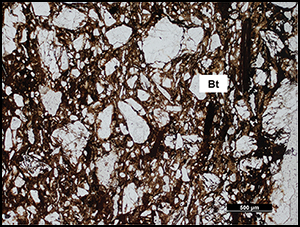Crossref Citations
This article has been cited by the following publications. This list is generated based on data provided by
Crossref.
David, Romain
and
Salvatori, Sandro
2018.
Encyclopedia of Global Archaeology.
p.
1.
Sterba, Johannes H.
2018.
A workflow for neutron activation analysis of archaeological ceramics at the Atominstitut in Vienna, Austria.
Journal of Radioanalytical and Nuclear Chemistry,
Vol. 316,
Issue. 2,
p.
753.
Hildebrand, Elisabeth
Garcea, Elena A. A.
Florenzano, Assunta
and
Mercuri, Anna Maria
2018.
Plants and People in the African Past.
p.
215.
Eerkens, Jelmer W.
de Voogt, Alex
Dupras, Tosha L.
Francigny, Vincent
and
Greenwald, Alexandra M.
2018.
Early childhood diets on the Nile: δ13C and δ15N in serial samples of permanent first molars in an elite Meroitic population from Sai Island, Sudan.
International Journal of Osteoarchaeology,
Vol. 28,
Issue. 5,
p.
552.
Womack, Andrew
Wang, Hui
Zhou, Jing
and
Flad, Rowan
2019.
A petrographic analysis of clay recipes in Late Neolithic north-western China: continuity and change.
Antiquity,
Vol. 93,
Issue. 371,
p.
1161.
Florenzano, Assunta
Mercuri, Anna Maria
Fornaciari, Rita
and
Garcea, Elena A.A.
2019.
Plants, water and humans: pollen analysis from Holocene archaeological sites on Sai Island, northern Sudan.
Palynology,
Vol. 43,
Issue. 1,
p.
22.
Garcea, Elena A. A.
2020.
The Prehistory of the Sudan.
p.
67.
Garcea, Elena A. A.
2020.
The Prehistory of the Sudan.
p.
117.
Garcea, Elena A. A.
2020.
The Prehistory of the Sudan.
p.
161.
Xie, Ru Hong
Feng, Jun Jie
and
Feng, Shan Xin
2020.
Application Research of High Temperature Silver Plating in Products.
Materials Science Forum,
Vol. 980,
Issue. ,
p.
70.
Garcea, Elena A. A.
2020.
The Prehistory of the Sudan.
p.
141.
David, Romain
and
Salvatori, Sandro
2020.
Encyclopedia of Global Archaeology.
p.
2067.
Garcea, Elena A.A.
D'Ercole, Giulia
Sterba, Johannes H.
Dunne, Julie
Manning, Katie
Gillard, Toby
Evershed, Richard P.
Varadzin, Ladislav
and
Varadzinová, Lenka
2020.
Technological variability in foragers’ pottery productions at the early-mid Holocene site of Sphinx, western part of Jebel Sabaloka, Sudan.
Quaternary International,
Vol. 555,
Issue. ,
p.
110.
Womack, Andrew
Liu, Li
and
Di, Nan
2021.
Initial insights into ceramic production and exchange at the early Bronze Age citadel at Shimao, Shaanxi, China.
Archaeological Research in Asia,
Vol. 28,
Issue. ,
p.
100319.
Womack, Andrew
Flad, Rowan
Zhou, Jing
Brunson, Katherine
Toro, Fabian H.
Su, Xin
Hein, Anke
d’Alpoim Guedes, Jade
Jin, Guiyun
Wu, Xiaohong
and
Wang, Hui
2021.
The Majiayao to Qijia transition: exploring the intersection of technological and social continuity and change.
Asian Archaeology,
Vol. 4,
Issue. 2,
p.
95.
D’Ercole, Giulia
2021.
Seventy Years of Pottery Studies in the Archaeology of Mesolithic and Neolithic Sudan.
African Archaeological Review,
Vol. 38,
Issue. 2,
p.
345.
de Souza, Aaron M.
and
Ownby, Mary F.
2022.
Re-assessing Middle Nubian cultural constructs through ceramic petrography.
African Archaeological Review,
Vol. 39,
Issue. 1,
p.
35.
Womack, Andrew
Li, Xinwei
Guo, Zhiwei
Wang, Hui
Zhou, Jing
and
Flad, Rowan
2023.
From local to long-distance: Neolithic and Bronze Age ceramic networks in north-western China.
Antiquity,
Vol. 97,
Issue. 395,
p.
1119.
Spagnolo, Vincenzo
and
Garcea, Elena A.A.
2023.
From settlement patterns to memory of place among Holocene hunter-gatherers at Sai Island, Middle Nile Valley.
Azania: Archaeological Research in Africa,
Vol. 58,
Issue. 2,
p.
161.





